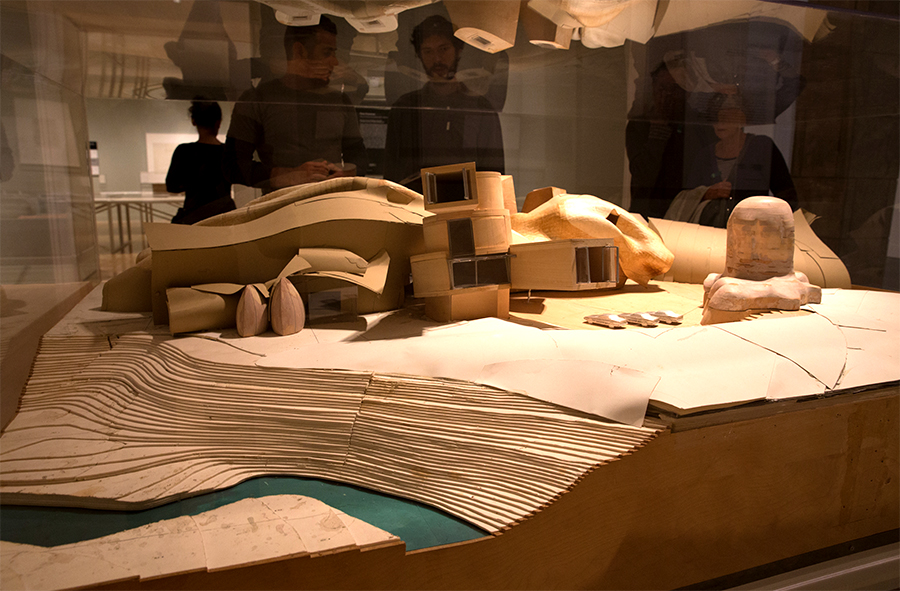Looking at Donovan Wylie’s photos of Ireland’s Maze Prison at the Canadian Centre for Architecture (CCA) is much like walking through a mall on Labour Day. The absurdity of the place is pretty obvious – but it can be monotonous too. Unlike a mall on Labour Day, the exhibition is at times gripping, but ultimately relies too often on its context to draw a response.
In a grossly oversimplified nutshell, the campaign for the (Protestant) British Northern Ireland to join the (Catholic) Republic of Ireland has been a divisive issue for well over a century. Often leading to extreme violence, and continuing in a tamer form to this day, the issue has always been politically troublesome.
The defining protests of Maze Prison began in 1976, when inmates who demanded to be treated as prisoners of war (as opposed to common criminals) refused to wear uniforms. This led to prison guards barring them from using toilets, which in turn created the “dirty protests,” where prisoners smeared the cell walls with their own feces.
Wylie’s work includes a long sequence of cell photos, every wall perfectly whitewashed; the only difference between them is the pattern of the curtains. In an introductory talk, Montreal’s Le Mois de la Photo curator, Paul Wombell, spoke about “photographers being witnesses to events,” but in this case, Wylie has arrived 25 years too late, capturing the physical transience of the protest rather than the protest itself. In this instance, though, he also manages to capture a more fundamental horror of imprisonment that goes beyond the experience at Maze.
Unfortunately Wylie’s pictures are not always as successful as the “cell room” photos are. The photographic journey around the “inertia” perimeter wall, for example, is considerably less resonant. (Fun fact: “inertia” is a gravel-filled area between prison walls, designed to sound out movement; a “sterile” area is made of concrete, designed to break the ankles of escapees landing on it.)
Every one of the 26 “stages” of the wall has its own photo. Each photo is taken in the exact same light and shows an identical composition.
Like the “cell room” sequence, what the “inertia” sequence fails to capture is the unique history of the prison. Unlike the cell rooms, it also fails to engage visually. It was through “inertia” and then “sterile” that 38 prisoners managed to escape, after shooting 2 guards, injuring another 20, and causing another to die of a heart attack.
According to Wylie, the feeling viewers experience upon seeing these photos is one of “entrapment” – but in most cases entrapment quickly leads to boredom. Finding evocative photos in an abandoned prison is clearly a difficult task (Wylie should know, he spent 100 days trying), but evidence suggests that it is far from impossible. A concrete chapel surrounded by an unnerving barbed-wire pen is one pre-demolition gem, but most of Wylie’s best photos were taken during the actual demolition process between 2006 and 2008. Good examples include the “Inner Fence” (a huge pile of crumpled fencing), and the half demolished “Perimeter Wall” – both fairly exceptional within the collection, because when stripped of their context they still remain engaging.
For Wylie, photography is “good at description, and bad at experience,” and it’s true that the exhibition largely fails to capture what being in any prison would be like, let alone one as unique as the Maze. The photos also offer no judgement whatsoever on the experiences of those inside the prison, or the wider republican cause.
This objective approach may have something do with Wylie’s own background – the artist was born in 1971 of a Protestant mother and Catholic father. It may also be part of a wider cultural trend; Steve McQueen’s film, Hunger, would make an excellent companion piece to the exhibition. Similarly ambiguous – and actually set in Maze Prison – Hunger deals with the “dirty protest” and IRA member Bobby Sands’ fatal 1981 hunger strike.
At points it seems that Wylie’s goal was one more of reportage than art, something he himself admits to. “To take the photos I had to become a machine, like the prison itself,” explains Wylie. “I fell to the logic of it.”
Donovan Wylie’s exhibit H-BLOCK will run till December 5 in the Octagonal Gallery of the CCA (1920 Baile).
